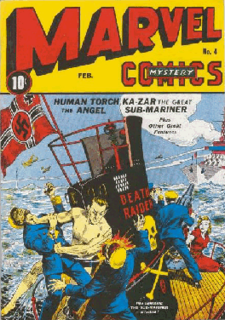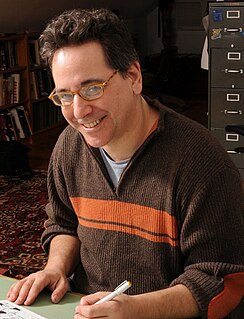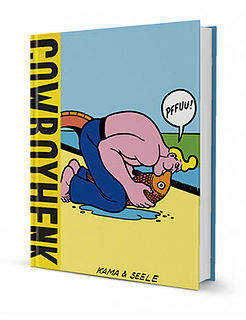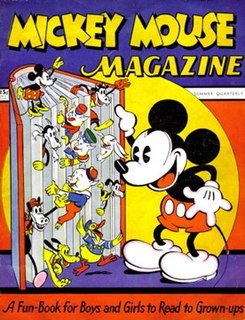Related Research Articles

A comic strip is a sequence of drawings, often cartoons, arranged in interrelated panels to display brief humor or form a narrative, often serialized, with text in balloons and captions. Traditionally, throughout the 20th and into the 21st century, these have been published in newspapers and magazines, with daily horizontal strips printed in black-and-white in newspapers, while Sunday papers offered longer sequences in special color comics sections. With the advent of the internet, online comic strips began to appear as webcomics.

A comic book, also called comicbook, comic magazine or simply comic, is a publication that consists of comics art in the form of sequential juxtaposed panels that represent individual scenes. Panels are often accompanied by descriptive prose and written narrative, usually, dialogue contained in word balloons emblematic of the comics art form. Although comics have some origins in 18th century Japan, comic books were first popularized in the United States and the United Kingdom during the 1930s. The first modern comic book, Famous Funnies, was released in the US in 1933 and was a reprinting of earlier newspaper humor comic strips, which had established many of the story-telling devices used in comics. The term comic book derives from American comic books once being a compilation of comic strips of a humorous tone; however, this practice was replaced by featuring stories of all genres, usually not humorous in tone.

A cartoon is a type of illustration that is typically drawn, sometimes animated, in an unrealistic or semi-realistic style. The specific meaning has evolved over time, but the modern usage usually refers to either: an image or series of images intended for satire, caricature, or humor; or a motion picture that relies on a sequence of illustrations for its animation. Someone who creates cartoons in the first sense is called a cartoonist, and in the second sense they are usually called an animator.
Doonesbury is a comic strip by American cartoonist Garry Trudeau that chronicles the adventures and lives of an array of characters of various ages, professions, and backgrounds, from the President of the United States to the title character, Michael Doonesbury, who has progressed from a college student to a youthful senior citizen over the decades.

The Katzenjammer Kids is an American comic strip created by Rudolph Dirks in 1897 and later drawn by Harold Knerr for 35 years. It debuted December 12, 1897, in the American Humorist, the Sunday supplement of William Randolph Hearst's New York Journal. The comic strip was turned into a stage play in 1903. It inspired several animated cartoons and was one of 20 strips included in the Comic Strip Classics series of U.S. commemorative postage stamps.

Sergio Aragonés Domenech is a Spanish/Mexican cartoonist and writer best known for his contributions to Mad magazine and creating the comic book Groo the Wanderer.

Archie Comic Publications, Inc., is an American comic book publisher headquartered in Pelham, New York. The company's many titles feature the fictional teenagers Archie Andrews, Jughead Jones, Betty Cooper, Veronica Lodge, Reggie Mantle, Sabrina Spellman, Josie and the Pussycats and Katy Keene.

Jack Ralph Cole was an American cartoonist best known for creating the comedic superhero Plastic Man, and his cartoons for Playboy magazine.

Darkwing Duck is an American animated superhero comedy television series produced by Disney Television Animation that first ran from 1991 to 1992 on both the syndicated programming block The Disney Afternoon and Saturday mornings on ABC. A total of ninety-one episodes were aired. It features the adventures of Darkwing Duck, who is the superheroic alter-ego of ordinary suburban duck Drake Mallard.

Usagi Yojimbo is a comic book series created by Stan Sakai. It is set primarily at the beginning of the Edo period of Japanese history and features anthropomorphic animals replacing humans. The main character is a rabbit rōnin, Miyamoto Usagi, whom Sakai based partially on the famous swordsman Miyamoto Musashi. Usagi wanders the land on a musha shugyō, occasionally selling his services as a bodyguard.

DuckTales is an American animated television series produced by Disney Television Animation. The original cartoon series premiered on syndication and on Disney Channel on September 18, 1987 and ran for a total of 100 episodes over four seasons, with its final episode airing on November 28, 1990. Based upon Uncle Scrooge and other Duck universe comic books created by Carl Barks, the show follows Scrooge McDuck, his three grandnephews Huey, Dewey, and Louie, and close friends of the group, on various adventures, most of which either involve seeking out treasure or thwarting the efforts of villains seeking to steal Scrooge's fortune or his Number One Dime.

Rocko's Modern Life is an American animated television series created by Joe Murray for Nickelodeon. The series centers on the surreal life of an anthropomorphic Australian immigrant wallaby named Rocko and his friends: the eccentric steer Heffer Wolfe, the neurotic turtle Filburt, and Rocko's faithful dog Spunky. It is set in the fictional town of O-Town. Throughout its run to present day, this show is controversial for its adult humor, including double entendre, innuendo, and satirical social commentary, similar to The Ren & Stimpy Show. The series has gained a cult following.

Marvel Mystery Comics is an American comic book series published during the 1930s–1940s period known to fans and historians as the Golden Age of Comic Books. It was the first publication of Marvel Comics' predecessor, Timely Comics, a division of Timely Publications.

Terry LaBan is an alternative/underground cartoonist and newspaper comic strip artist. He is known for his comic book series Cud, and his syndicated strip Edge City, created with his wife, Patty LaBan, a couples and family therapist.
Michael Aushenker is an independent American comic-book artist and creator based in Los Angeles, California, best known for the comic book series El Gato, Crime Mangler. He has also created Chipmunks & Squirrels, Those Unstoppable Rogues, and Cartoon Flophouse, and his work has appeared in such publications as Heavy Metal (magazine), Duplex Planet, Instant Classics, The Stranger, Cake, and Filth.
This is a timeline of significant events in comics prior to the 20th century.

Cowboy Henk is a Belgian absurd humor/surreal humour gag-a-day comic strip series, drawn by Herr Seele and written by Kamagurka. It was originally published in the newspaper De Morgen, but later taken over by the magazine HUMO in which it is still published today and for whom Henk is now their mascot. The series was in continuous syndication from 1981 until 2011. After the brief interruption it was continued again in the spring of 2013.
The history of American comics began in the 19th century in mass print media, in the era of sensationalist journalism, where newspaper comics served as further entertainment for mass readership. In the 20th century, comics became an autonomous art medium and an integral part of American culture.

Mickey Mouse Magazine is an American Disney comics publication that preceded the popular 1940 anthology comic book Walt Disney's Comics and Stories. There were three versions of the title -- two promotional giveaway magazines published from 1933 to 1935, and a newsstand magazine published from 1935 to 1940. The publication gradually evolved from a 16-page booklet of illustrated text stories and single-page comic panels into a 64-page comic book featuring reprints of the Mickey Mouse and Donald Duck comic strips.
References
- ↑ "Taking 'The 5th'". Press-Telegram. October 15, 1997. Retrieved 22 September 2013.
- ↑ "Many Publications Are Taking 'The 5th.'". Editor & Publisher, Vol. 130, No. 5. Retrieved 22 September 2013.
- ↑ "Catch The 5th Wave Debut". Contra Costa. October 26, 1997. Retrieved 22 September 2013.
- ↑ "The 5th Wave FAQ" . Retrieved 2010-06-21.